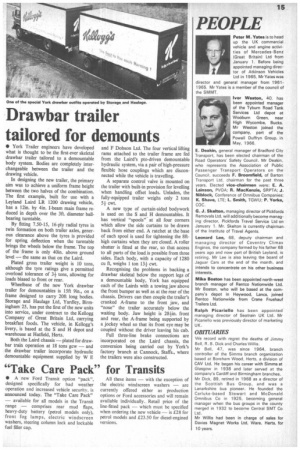Drawbar trailer tailored for demounts
Page 17

If you've noticed an error in this article please click here to report it so we can fix it.
• York Trailer engineers have developed what is thought to be the first-ever skeletal drawbar trailer tailored to a demountable body system. Bodies are completely interchangeable between the trailer and the drawing vehicle.
In designing the new trailer, the primary aim was to achieve a uniform frame height between the two halves of the combination. The first example, built for use with a Leyland Laird LR 1200 drawing vehicle, has a 12in. by 4in. I-beam main frame reduced in depth over the 3ft. diameter ballbearing turntable.
By fitting 7.50-15, 16-ply radial tyres in twin formation on both trailer axles, gener ous clearance above the tyres is provided for spring, deflection when the turntable brings the wheels below the frame. The top of the frame is only 40in. above ground level — the same as that on the Laird.
Plated gross trailer weight is 10 tons, although the tyre ratings give a permitted overload tolerance of 3+ tons, allowing for loads biased to front or rear.
Wheelbase of the new York drawbar trailer for demountables is 15ft 9in., on a frame designed to carry 20ft long bodies.
Storage and Haulage Ltd, Yardley, Birmingham 25, has put the first of the new units
into service, under contract to the Kellogg Company of Great Britain Ltd, carrying breakfast foods. The vehicle, in Kellogg's livery, is based at the S and H depot and warehouse at Hatfield, Herts.
Both the Laird chassis —plated for drawbar train operation at 18 tons gew — and the drawbar trailer incorporate hydraulic demountable equipment supplied by W E and F Dobson Ltd. The four vertical lifting rams attached to the trailer frame are fed from the Laird's pto-driven demountable hydraulic system, via a pair of high-pressure flexible hose couplings which are disconnected while the vehicle is travelling.
A separate control valve is mounted on the trailer with built-in provision for levelling when handling offset loads. Unladen, the fully-equipped trailer weighs only 2 tons 5+ cwt.
A new type of curtain-sided bodywork is used on the S and demountables. It has vertical "spools" at all four corners which allow the side curtains to be drawn back from either end. A ratchet at the base of each spool is used for tightening the 8fthigh curtains when they are closed. A roller shutter is fitted at the rear, so that access to all parts of the load is possible from three sides. Each body, with a capacity of 1280 Cu ft, weighs 1 ton 13+ cwt.
Recognising the problems in backing a drawbar skeletal below the support legs of a demountable body, York has equipped each of the Lairds with a towing jaw above the front bumper as well as at the rear of the chassis. Drivers can then couple the trailer's cranked A-frame to the front jaw, and "nose" the trailer accurately below the waiting body. Jaw height is 28fin. front and rear, the A-frame being supported by a jockey wheel so that its front eye may be coupled without the driver leaving his cab.
Full three-line brake connections are incorporated on the Laird chassis, the conversion being carried out by York's factory branch at Cannock, Staffs., where the trailers were also constructed.




































































